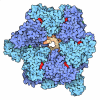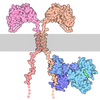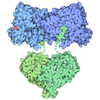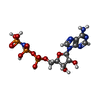+ Open data
Open data
- Basic information
Basic information
| Entry | Database: PDB / ID: 9cdf | |||||||||
|---|---|---|---|---|---|---|---|---|---|---|
| Title | Structure of MORC2 PD mutant binding to AMP-PNP | |||||||||
 Components Components | ATPase MORC2 | |||||||||
 Keywords Keywords | DNA BINDING PROTEIN / Chromatin remodeller / complex / ATPase | |||||||||
| Function / homology |  Function and homology information Function and homology informationconstitutive heterochromatin formation / transposable element silencing by heterochromatin formation / Fatty acyl-CoA biosynthesis / Hydrolases; Acting on acid anhydrides; In phosphorus-containing anhydrides / heterochromatin / Regulation of endogenous retroelements by the Human Silencing Hub (HUSH) complex / fatty acid metabolic process / nuclear matrix / chromatin remodeling / DNA damage response ...constitutive heterochromatin formation / transposable element silencing by heterochromatin formation / Fatty acyl-CoA biosynthesis / Hydrolases; Acting on acid anhydrides; In phosphorus-containing anhydrides / heterochromatin / Regulation of endogenous retroelements by the Human Silencing Hub (HUSH) complex / fatty acid metabolic process / nuclear matrix / chromatin remodeling / DNA damage response / chromatin binding / magnesium ion binding / protein homodimerization activity / ATP hydrolysis activity / zinc ion binding / nucleoplasm / ATP binding / identical protein binding / nucleus / cytoplasm / cytosol Similarity search - Function | |||||||||
| Biological species |  Homo sapiens (human) Homo sapiens (human) | |||||||||
| Method | ELECTRON MICROSCOPY / single particle reconstruction / cryo EM / Resolution: 2.39 Å | |||||||||
 Authors Authors | Tan, W. / Shakeel, S. | |||||||||
| Funding support |  Australia, 2items Australia, 2items
| |||||||||
 Citation Citation |  Journal: Nat Commun / Year: 2025 Journal: Nat Commun / Year: 2025Title: MORC2 is a phosphorylation-dependent DNA compaction machine. Authors: Winnie Tan / Jeongveen Park / Hariprasad Venugopal / Jieqiong Lou / Prabavi Shayana Dias / Pedro L Baldoni / Kyoung-Wook Moon / Toby A Dite / Christine R Keenan / Alexandra D Gurzau / ...Authors: Winnie Tan / Jeongveen Park / Hariprasad Venugopal / Jieqiong Lou / Prabavi Shayana Dias / Pedro L Baldoni / Kyoung-Wook Moon / Toby A Dite / Christine R Keenan / Alexandra D Gurzau / Joonyoung Lee / Timothy M Johanson / Andrew Leis / Jumana Yousef / Vineet Vaibhav / Laura F Dagley / Ching-Seng Ang / Laura D Corso / Chen Davidovich / Stephin J Vervoort / Gordon K Smyth / Marnie E Blewitt / Rhys S Allan / Elizabeth Hinde / Sheena D'Arcy / Je-Kyung Ryu / Shabih Shakeel /    Abstract: The Microrchidia (MORC) family of chromatin-remodelling ATPases is pivotal in forming higher-order chromatin structures that suppress transcription. The exact mechanisms of MORC-induced chromatin ...The Microrchidia (MORC) family of chromatin-remodelling ATPases is pivotal in forming higher-order chromatin structures that suppress transcription. The exact mechanisms of MORC-induced chromatin remodelling have been elusive. Here, we report an in vitro reconstitution of full-length MORC2, the most commonly mutated MORC member, linked to various cancers and neurological disorders. MORC2 possesses multiple DNA-binding sites that undergo structural rearrangement upon DNA binding. MORC2 locks onto the DNA using its C-terminal domain (CTD) and acts as a clamp. A conserved phosphate-interacting motif within the CTD was found to regulate ATP hydrolysis and cooperative DNA binding. Importantly, MORC2 mediates chromatin remodelling via ATP hydrolysis-dependent DNA compaction in vitro, regulated by the phosphorylation state of its CTD. These findings position MORC2 CTD phosphorylation as a critical regulator of chromatin remodelling and a promising therapeutic target. | |||||||||
| History |
|
- Structure visualization
Structure visualization
| Structure viewer | Molecule:  Molmil Molmil Jmol/JSmol Jmol/JSmol |
|---|
- Downloads & links
Downloads & links
- Download
Download
| PDBx/mmCIF format |  9cdf.cif.gz 9cdf.cif.gz | 435.7 KB | Display |  PDBx/mmCIF format PDBx/mmCIF format |
|---|---|---|---|---|
| PDB format |  pdb9cdf.ent.gz pdb9cdf.ent.gz | 288.4 KB | Display |  PDB format PDB format |
| PDBx/mmJSON format |  9cdf.json.gz 9cdf.json.gz | Tree view |  PDBx/mmJSON format PDBx/mmJSON format | |
| Others |  Other downloads Other downloads |
-Validation report
| Arichive directory |  https://data.pdbj.org/pub/pdb/validation_reports/cd/9cdf https://data.pdbj.org/pub/pdb/validation_reports/cd/9cdf ftp://data.pdbj.org/pub/pdb/validation_reports/cd/9cdf ftp://data.pdbj.org/pub/pdb/validation_reports/cd/9cdf | HTTPS FTP |
|---|
-Related structure data
| Related structure data |  45474MC  9cdgC  9cdhC  9cdiC  9cdjC M: map data used to model this data C: citing same article ( |
|---|---|
| Similar structure data | Similarity search - Function & homology  F&H Search F&H Search |
- Links
Links
- Assembly
Assembly
| Deposited unit | 
|
|---|---|
| 1 |
|
- Components
Components
| #1: Protein | Mass: 117907.500 Da / Num. of mol.: 2 / Mutation: S725A, S730A, S739A, S743A, S777A, S779A Source method: isolated from a genetically manipulated source Details: phospho-dead (PD) mutant / Source: (gene. exp.)  Homo sapiens (human) / Gene: MORC2, KIAA0852, ZCWCC1 / Plasmid: pAcebac / Cell line (production host): Sf9 / Production host: Homo sapiens (human) / Gene: MORC2, KIAA0852, ZCWCC1 / Plasmid: pAcebac / Cell line (production host): Sf9 / Production host:  References: UniProt: Q9Y6X9, Hydrolases; Acting on acid anhydrides; In phosphorus-containing anhydrides #2: Chemical | #3: Chemical | #4: Chemical | Has ligand of interest | Y | Has protein modification | N | |
|---|
-Experimental details
-Experiment
| Experiment | Method: ELECTRON MICROSCOPY |
|---|---|
| EM experiment | Aggregation state: PARTICLE / 3D reconstruction method: single particle reconstruction |
- Sample preparation
Sample preparation
| Component | Name: MORC2 phospho-dead (PD) mutant / Type: COMPLEX / Entity ID: #1 / Source: RECOMBINANT |
|---|---|
| Molecular weight | Value: 0.239 MDa / Experimental value: YES |
| Source (natural) | Organism:  Homo sapiens (human) Homo sapiens (human) |
| Source (recombinant) | Organism:  |
| Buffer solution | pH: 8 / Details: 20 mM HEPES pH 8, 60 mM KCl, 2 mM MgCl2, 1 mM DTT |
| Specimen | Conc.: 0.5 mg/ml / Embedding applied: NO / Shadowing applied: NO / Staining applied: NO / Vitrification applied: YES Details: This sample was monodisperse, in the presence of 2.5 mM AMP-PNP. |
| Specimen support | Grid material: GOLD / Grid mesh size: 300 divisions/in. / Grid type: Quantifoil R1.2/1.3 |
| Vitrification | Instrument: FEI VITROBOT MARK IV / Cryogen name: ETHANE / Humidity: 100 % / Chamber temperature: 277 K |
- Electron microscopy imaging
Electron microscopy imaging
| Experimental equipment |  Model: Titan Krios / Image courtesy: FEI Company |
|---|---|
| Microscopy | Model: TFS KRIOS |
| Electron gun | Electron source:  FIELD EMISSION GUN / Accelerating voltage: 300 kV / Illumination mode: FLOOD BEAM FIELD EMISSION GUN / Accelerating voltage: 300 kV / Illumination mode: FLOOD BEAM |
| Electron lens | Mode: BRIGHT FIELD / Calibrated magnification: 105000 X / Nominal defocus max: 1100 nm / Nominal defocus min: 400 nm / Cs: 2.7 mm / C2 aperture diameter: 50 µm / Alignment procedure: BASIC |
| Specimen holder | Cryogen: NITROGEN / Specimen holder model: FEI TITAN KRIOS AUTOGRID HOLDER / Temperature (max): 310 K / Temperature (min): 196 K |
| Image recording | Average exposure time: 1 sec. / Electron dose: 50 e/Å2 / Film or detector model: GATAN K3 (6k x 4k) / Num. of grids imaged: 4 / Num. of real images: 5816 |
- Processing
Processing
| EM software |
| ||||||||||||||||||||||||
|---|---|---|---|---|---|---|---|---|---|---|---|---|---|---|---|---|---|---|---|---|---|---|---|---|---|
| CTF correction | Type: PHASE FLIPPING AND AMPLITUDE CORRECTION | ||||||||||||||||||||||||
| Particle selection | Num. of particles selected: 2630765 | ||||||||||||||||||||||||
| Symmetry | Point symmetry: C2 (2 fold cyclic) | ||||||||||||||||||||||||
| 3D reconstruction | Resolution: 2.39 Å / Resolution method: FSC 0.143 CUT-OFF / Num. of particles: 201271 / Algorithm: FOURIER SPACE / Num. of class averages: 1 / Symmetry type: POINT | ||||||||||||||||||||||||
| Atomic model building | B value: 63 / Protocol: AB INITIO MODEL / Space: REAL / Target criteria: Cross-correlation coefficient | ||||||||||||||||||||||||
| Atomic model building | PDB-ID: 5OF9 Accession code: 5OF9 / Chain residue range: 1-603 Details: The initial model consisted of the complete biological assembly for PDB entry 5OF9. Pdb chain residue range: 1-603 / Source name: PDB / Type: experimental model | ||||||||||||||||||||||||
| Refinement | Cross valid method: NONE Stereochemistry target values: GeoStd + Monomer Library + CDL v1.2 | ||||||||||||||||||||||||
| Displacement parameters | Biso mean: 74.36 Å2 | ||||||||||||||||||||||||
| Refine LS restraints |
|
 Movie
Movie Controller
Controller







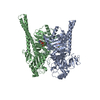
 PDBj
PDBj
